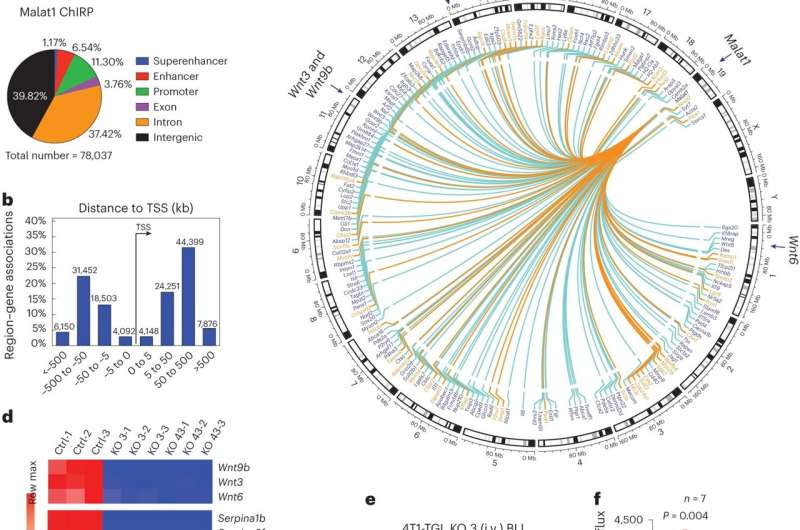This article has been reviewed according to Science X's editorial process and policies. Editors have highlighted the following attributes while ensuring the content's credibility:
fact-checked
peer-reviewed publication
trusted source
proofread
What reactivates dormant cancer cells?

Researchers at Columbia University have found a molecule that is responsible for arousing dormant cells from breast cancer and nudging them to create metastases. Silencing this molecule, called Malat1, in mice with breast cancer reduced metastases and improved survival, suggesting that a similar treatment could benefit patients.
In recent years, cancer researchers have come to understand that early in tumor development, some cancer cells escape the primary tumor, travel to distant parts of the body, and hibernate, only to awaken years or even decades later to form metastases.
What controls this phenomenon—known as cancer dormancy—is poorly understood. However, because metastases cause most cancer-related deaths, better insights into dormancy could lead to substantial improvements in treatment.
A double shot for wakening
Malat1, previously associated with a variety of cancers, is a long noncoding RNA (lncRNA), a type of RNA with diverse roles in gene regulation.
In a previous study of mice, the researchers conducted a genetic screen to uncover factors that might contribute to the reactivation of dormant metastatic breast cancer cells. One of the most compelling "hits" was Malat1.
In the new study, the researchers first found that Malat1 activity is indispensable for awakening dormant cells and creating metastases. When they deleted the Malat1 gene from breast cancer cells in mice, they almost completely suppressed the cells' ability to colonize the lung and create metastases. Increasing levels of Malat1, on the other hand, had the opposite effect, increasing metastasis and reducing survival in a mouse model of breast cancer.
The researchers then examined how Malat1 works.
"We found that Malat1 exerts a double whammy in dormant cancer cells. First, it activates gene expression pathways that wake the cells up and makes them more likely to proliferate and form new tumors. Second, Malat1 stimulates the production of molecules that block the immune system from recognizing and destroying the newly activated cancer cells," says Benjamin Izar, MD, Ph.D., a co-leader of the study and assistant professor of medicine at Columbia University Vagelos College of Physicians and Surgeons.
"In other words, Malat1 affects the behavior of the dormant cancer as well as the surrounding tumor microenvironment," adds Dhiraj Kumar, Ph.D., associate research scientist in genetics & development and the study's lead author.
Putting cells back to sleep
Given Malat1's vital role in dormancy and metastasis, turning Malat1 off may have potential in treating metastatic cancer or preventing metastases from developing.
To explore this potential, the researchers showed that Malat1 can be inhibited with antisense oligonucleotides (ASOs), an emerging form of drug therapy in which short, synthetic pieces of single-stranded DNA are designed to lock on to specific RNA molecules and disable them.
"In our mouse model of breast cancer, the administration of ASOs dramatically reduced the development of lung metastases," Kumar says. Such drugs could potentially prevent or treat metastases in other cancers, Kumar adds, since Malat1 appears to play a role in the metastasis of colon, lung, and skin cancer.
Still unknown is the initial factor that leads to greater Malat1 expression.
"It is difficult to say, but one variable that confers cumulative risk for reactivation is time," Izar says. "Dormant cancer cells probably awaken all the time, but they get recognized by the immune system and then destroyed. This protective effect may weaken with aging."
The study is published in the journal Nature Cancer.
More information: Dhiraj Kumar et al, LncRNA Malat1 suppresses pyroptosis and T cell-mediated killing of incipient metastatic cells, Nature Cancer (2024). DOI: 10.1038/s43018-023-00695-9



















